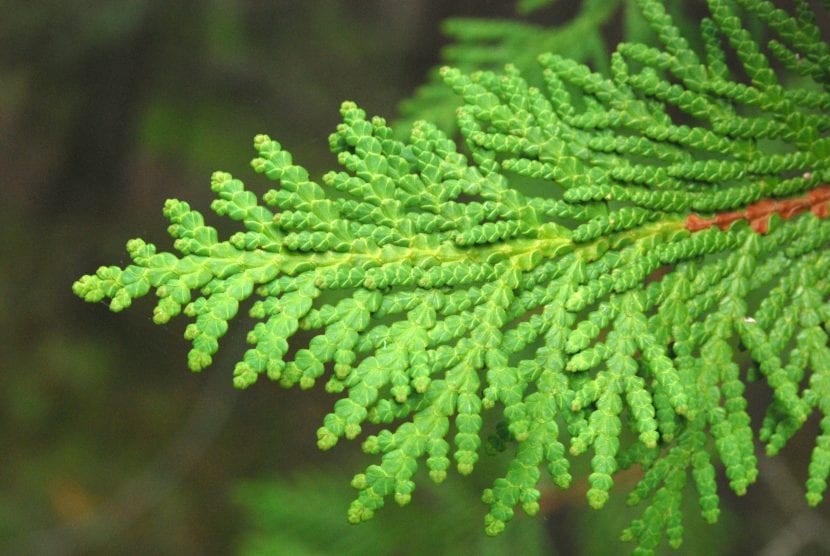
Image - Wikimedia / Joshua Mayer
La Thuja occidentalis it is a very adaptable conifer, so much so that it can be had as a tree or as a shrub a few meters high. As it also remains evergreen, it is a very interesting species so that the garden - or the patio 😉 - looks alive every day of the year.
Its growth and development rate is not the fastest in the world, but it is not slow either, which will allow you to control it very easily. Know her.
Origin and characteristics
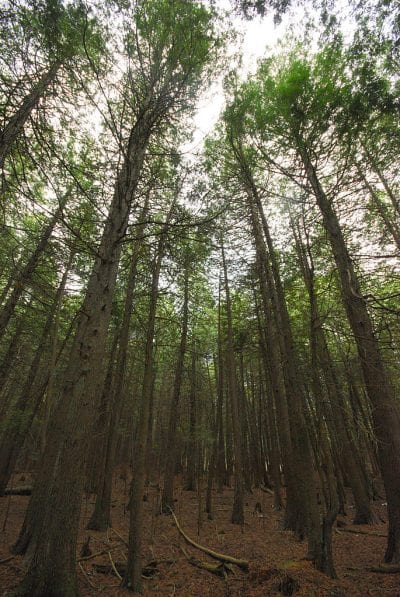
Image - Wikimedia / Joshua Mayer
It is a tree, or to be more exact a conifer, known as Canadian thuja or western thuja, which belongs to the Cupressaceae family. It is native to the northeastern United States and southeastern Canada. It grows to a height of between 10 and 20 meters. (maximum 35), with a trunk of up to 40-60cm in diameter.
Its very small leaves, 3-5mm long, green in color. These fall gradually, very slowly, as new ones appear throughout the year. The fruit is a cone that, when ripe, is brown in color, measuring 10-15mm by 4-5mm wide, and contains about 7 seeds.
It has a very long life expectancy, being able to exceed 1000 years. The oldest that has been discovered died at 1500 years old, and lived on South Manitou Island, in Leelanau County, Michigan (United States).
Cultivars
There are several, among which we highlight:
- Golden Globe: it measures one meter in height, has a dwarf bearing and a spherical shape.
- Lutescens: its bearing is pyramidal and the leaves are yellowish.
- pyramidalis Compact: its bearing is columnar.
- Rheingold: its bearing is spherical, and its leaves are yellowish.
What are their cares?
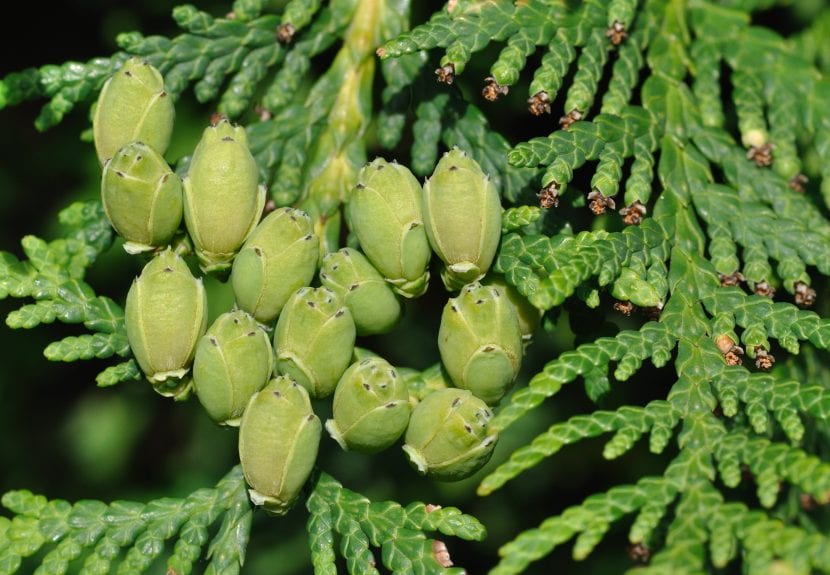
Image - Wikimedia / Quartl
If you want to have a copy, we recommend you take care of it as follows:
Location
La Thuja occidentalis has to be outside, in full sun or, failing that, in a bright area. It is not an invasive plant, but its roots need space so it is advisable to keep it at a minimum distance of 4-5 meters from the pipes (it does nothing to the walls, walls, etc., in fact when it is kept as a hedge it is usual that it is planted a few centimeters from these).
Earth
- Garden: grows in well-drained soils, preferably fertile and deep.
- Flower pot: can be filled with universal plant substrate (on sale here), or if preferred, with mulch (on sale here) or even a specific one for garden plants (for sale here) which is richer in nutrients.
Irrigation
It does not withstand drought. This is a conifer that needs frequent waterings in summer, and somewhat more scarce during the rest of the year. But also, you have to know that excess watering hurts it a lot, to the point that once its roots start to rot, it is difficult for it to get ahead. With this in mind, it is important that the soil or substrate drains the water well and quickly, and that the humidity is checked before moistening them again, for example with a thin wooden stick.
Thus, you will see that, depending on the weather, you may need about 3 or 4 weekly irrigations during the hottest and dry season, and 1-2 weekly the rest of the year.
Subscriber
From the beginning of spring to the end of summer, it is highly recommended to fertilize yours from Canada with organic fertilizers:
- If it's in the garden: use mulch, compost, or the like. Spread a layer about 3-4cm thick around the trunk, and water.
- If it is potted: use liquid fertilizers, such as liquid guano for example (for sale here), following the indications specified on the package.
Pruning
It could late winter, removing dry, diseased, weak branches and those that are broken. Take the opportunity to cut those that are growing too much. Use pruning tools previously disinfected with pharmacy rubbing alcohol or a few drops of dishwasher.
When finished, put healing paste on the wounds (on sale here), in all of them, but especially in the largest ones (those over 0,5cm in diameter).
Multiplication
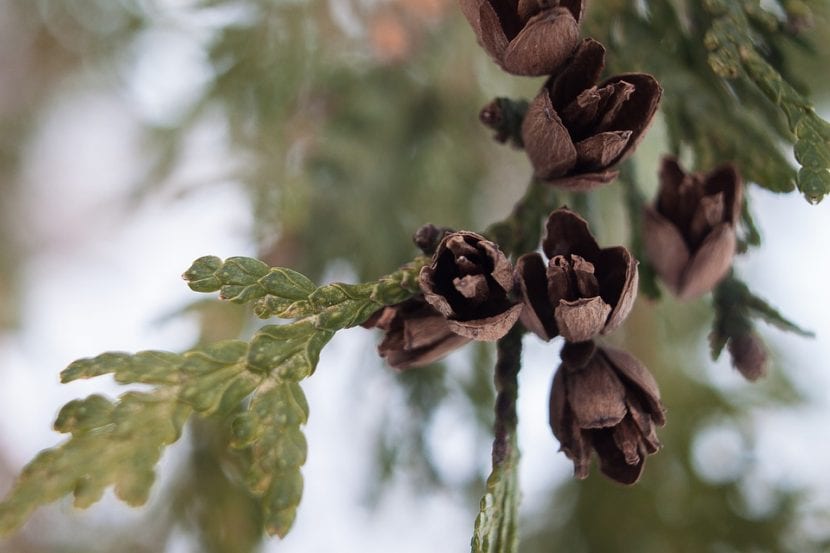
La Thuja occidentalis multiplies by seeds in winter and by cuttings in mid-summer. How do you proceed in each case? Let's see it:
Seeds
The first thing to do is stratify them, that is, to sow them in a tupperware with a sterile substrate (that is, new, unused), previously moistened with water, and then place said container in the refrigerator for three months. Do not forget to remove it once a week and remove the lid so that the air is renewed and thus avoid the appearance of fungus.
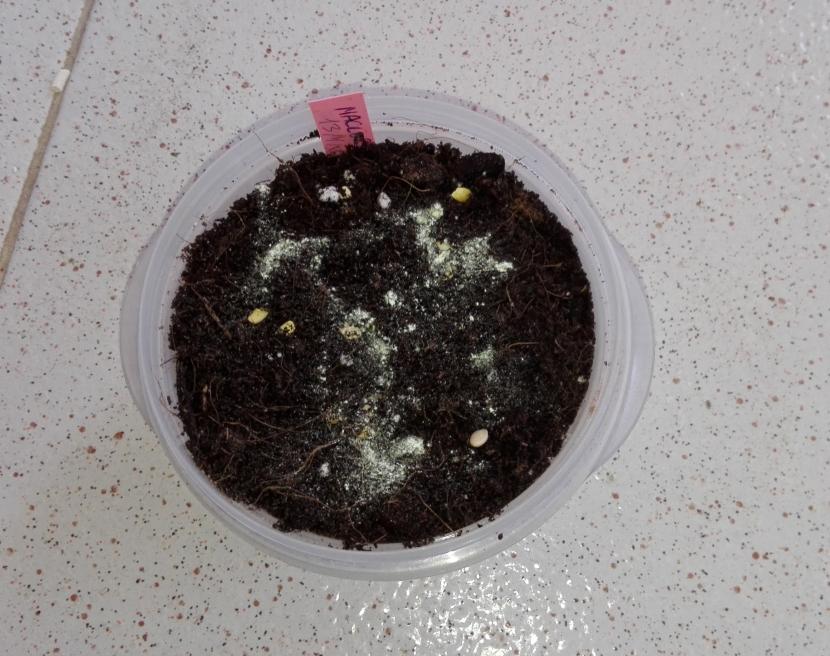
After that time, they are sown in seedbeds (like this one they sell here), with cultivation substrate, finally it is placed outside, in semi-shade.
If all goes well, they will germinate throughout the spring.
Stakes
Twigs of about 15cm long are cut from somewhat hard wood at the base, and then they are put to root in pots with substrate wrapped with plastic (they can be put in transparent plastic bags in which some holes will have been made so that the air can circulate).
To make them more likely to root, it is advisable to impregnate the base with liquid rooting hormones (on sale here).
Planting or transplanting time
In spring, when the risk of frost has passed. If you have it in a pot, transplant it to a larger one every two or three years.
Pests
It is quite resistant, but can be affected by:
- Spider webs: as the Paratetranychus ununguis, which causes desiccation of the leaves. It is treated with anti-spider insecticide.
- Borers: as the Phloeosinus thujae, they make holes in the trunk and branches, causing the general weakening of the plant. It is treated with copper-based insecticides.
- Mealybugs: they can be cottony or limpet type, in any case, they feed on the sap of the tender shoots and are eliminated with anti-mealybugs or with diatomaceous earth (for sale here).
Management
You may have the following:
- seridium: they are fungi that cause the desiccation of the leaves and the appearance of cankers. It is fought with fungicides.
- Spring browning: if at the end of winter and / or early spring the land is frozen but the temperature is high, the leaves turn brown due to the fact that perspiration is more frequent than the provision of water by its root system.
It is not serious, but it can be watered with somewhat warm water until the earth is completely free of ice.
Rusticity
It resists frosts of up to -18ºC, and temperatures of up to 40ºC do not harm it too much as long as it has water (but not in excess, as we have said before in Irrigation).
What uses is given to Thuja occidentalis?
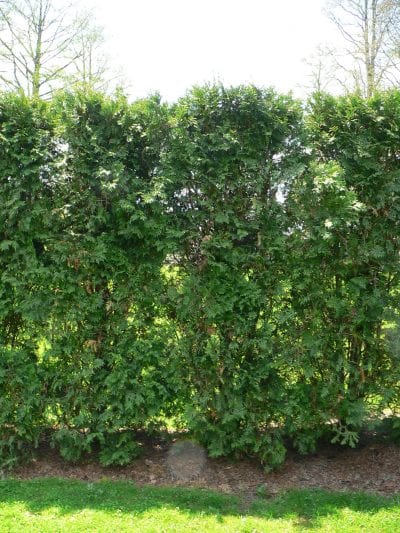
Image - Wikimedia / Raul654
Ornamental
It is a plant that is used above all as an ornamental, either as specimen isolated or in groups. It is highly appreciated as a hedge, for its adaptability and rusticity.
Wood
The wood from its trunk is used in naval and hydraulic construction.
What did you think of this conifer?
Very good info, thank you very much.
Thank you very much, Pablo.
Good afternoon, I have a Thuja that leaks resin, what can it be?
Thank you
Hi Miquel.
I might have gum. How often is it watered? An excess of irrigation favors the appearance of fungi, which attack the roots.
It can be treated with fungicides such as Alliette.
Greetings.